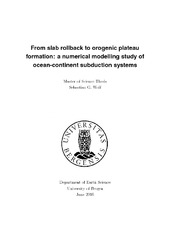From slab rollback to orogenic plateau formation: a numerical modelling study of ocean-continent subduction systems
Master thesis
Permanent lenke
https://hdl.handle.net/1956/12647Utgivelsesdato
2016-05-30Metadata
Vis full innførselSamlinger
- Department of Earth Science [1033]
Sammendrag
The crustal structures of overriding plates in subduction settings around the world can vary between a large variety of deformation styles, ranging from extensional structures and back arc opening induced by slab roll back, as e.g. in the Tonga-Kermadec subduction zone, to large, plateau-like orogens such as the central Andes. Several studies propose that the first order influence on the deformation style of the overriding plate is its movement away from or towards the trench and the 3D mantle flow pattern of the subduction zone. Other studies focussing on mountain building above subduction zones propose in addition that metamorphism of the lower continental crust is controlling orogeny, and that terrane accretion is a possibility for growth of active subduction margins. I attempt to test the above presented concepts with numerical, 2D thermo-mechanically coupled models of ocean-continent subduction. The model domain is on the upper mantle scale and subduction is decoupled from the lower mantle. I consider first order parameters like plate velocities and mantle flow as the main drivers for subduction and associated deformation on Earth, and vary those parameters to find the main factors controlling deformation. In a second modelling step, the influence of metamorphic densification reactions of the lower continental crust and long-term development of margins with accreted terranes is investigated. I find that every kind of deformation is preceded by corner flow induced thinning of the overriding plate. The corner flow velocity is proportional to the subduction velocity and thus a higher subduction velocity leads to faster thinning and deformation of the overriding plate. I find that return flow and overriding plate movement away from the trench are the main factors that lead to overriding plate extension and back-arc opening. Overriding plate movement towards the trench is the only factor which can lead to overriding plate shortening, but only if the movement rules out return flow induced trench retreat. These parameters are in accordance with a statistical analysis of the subduction zones on Earth, which shows that the models can reproduce first order subduction zone characteristics. A comparison of my models with active back-arc spreading centres shows that corner flow induced weakening is probably an important mechanism for lithospheric thinning on Earth. My models with shortening of the overriding plate are dominated by ablative subduction, and do not reproduce structures as e.g. found in the Andes. This shows that further modelling is necessary, for instance integrating lower mantle - slab interaction and a more realistic subduction channel rheology. Models investigating the influence of densification reactions and terrane accretion are also strongly influenced by ablative subduction, and further studies with more realistic subduction channel parameters are necessary. Yet the models show that densification of the lower continental crust can induce deformation and modifies shortening structures. Furthermore accretion of a weak terrane is possible, but subsequent subduction can modify the margin significantly.
